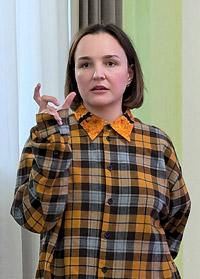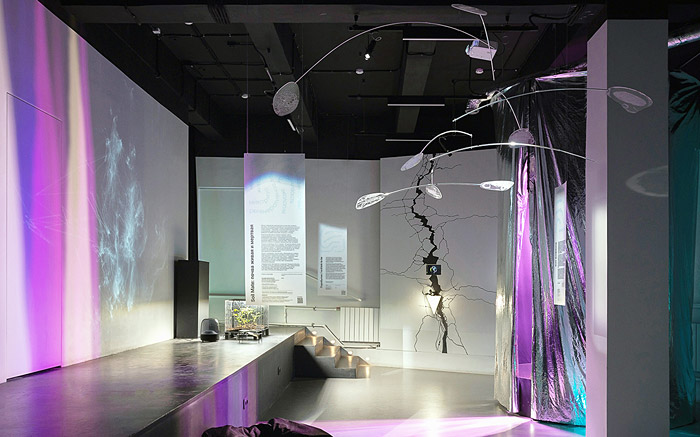
Electronic english version since 2022 |
The newspaper was founded in November 1957
| |
|
Number 38 (4736) |
This is a must see...
After the summer break, the lecture hall of the JINR Scientists' Club reopened. On 24 September, a meeting with the creative producer, the head of the ITMO University Master's programme in Art & Science, the co-founder of the NADO cultural projects agency Olga Vad was held here.
 The intersection of science, art and new technologies, the most interesting projects and exhibitions were presented in the lecture "Science in art: prerequisites and trends". Art & Science, according to the lecturer, develops in two paradigms: artistic and technological value systems. On the one hand, it interprets scientific problems, on the other hand, it formulates new questions for science. Very closely related to this phenomenon are the so-called new media (interactive electronic publications and new ways of communication between content producers and consumers - Ed.) that represent a way of communication and data transmission in a society concerning technology and scientific progress.
The intersection of science, art and new technologies, the most interesting projects and exhibitions were presented in the lecture "Science in art: prerequisites and trends". Art & Science, according to the lecturer, develops in two paradigms: artistic and technological value systems. On the one hand, it interprets scientific problems, on the other hand, it formulates new questions for science. Very closely related to this phenomenon are the so-called new media (interactive electronic publications and new ways of communication between content producers and consumers - Ed.) that represent a way of communication and data transmission in a society concerning technology and scientific progress.
Historically, the origin of Art & Science can be attributed to the end of the 1960s of the last century. The most famous event was the performance "Nine evenings: theater and engineering art" that was held in New York in October, 1966. It was held by a group of artists EAT (Experiments on art and science) and engineers from Bell Laboratories. The beginning of the collaboration between artists and technologists can also be attributed to the Pepsi pavilion at the Expo-70 exhibition in Osaka that was "covered" with a water cloud-sculpture by Fujiko Nakaya. Mirrors fixed in a special way reflected everything happening inside, created a hologram effect and visitors could see their upside-down reflection.
Speaking about the evolution of this trend in the USSR and Russia, Olga Vad mentioned the "Symphony of horns" performed from machine sounds by Arseny Avraamov in 1923, the Kazan Research Institute "Prometheus", where in 1962, a performance of the symphonic "Poem of fire" by A.Scriabin with a part of light was organized. The first digital cartoon was also mentioned, as well as a hymn to artificial intelligence, composed on the Ural-2 computer in 1977. Of the more modern well-known creative associations, she talked about the Yekaterinburg group of programmers and scientists "Where dogs run" and their exhibit "Kerosene chronicles. Mushroom" - about quite human behavior of robots thanks to the kerosene mushroom contained in them.

Afterwards, the lecturer moved on to the first Master's programme in Russia, Art & Science, at ITMO University. It welcomes graduates from both technological and creative specialties that wish to prove themselves in the field of scientific and technological art. Olga Vad spoke about the graduates' exhibition "Bytes and butterflies" that was held in June. It was dedicated to rethinking of the relationships between people, technology, the environment and animals. And these were very unusual projects - perfume for insects, hydrolytic precipitation of substances contained in the waters of the Gulf of Finland on the surface of a structure, the illusion of being in a glass of red wine...
Other world-famous projects were also discussed that of course, surprise with their technological advancement, unusual sensations and the authors' imagination. Of course, the lecture became an initial excursion into the bottomless and endless world of the commonwealth of science and art. A list of recommended references was even presented. And judging by the youth audience, this is a very interesting proposal for young scientists - both for revealing creative abilities and for popularizing natural science knowledge.
* * *
On 22 August, JINR Director Grigory Trubnikov and ITMO Rector Vladimir Vasiliev signed an agreement between the University and JINR. It defines the main areas of cooperation: joint creative projects in the field of "Science and art", cooperation in expert activities, holding joint seminars, scientific and practical conferences and meetings, as well as organizing internships. Assistant to Chief Scientific Secretary for Social and Cultural Development Varvara Fufaeva has been appointed as the coordinator of cooperation on the part of JINR.
Galina MYALKOVSKAYA